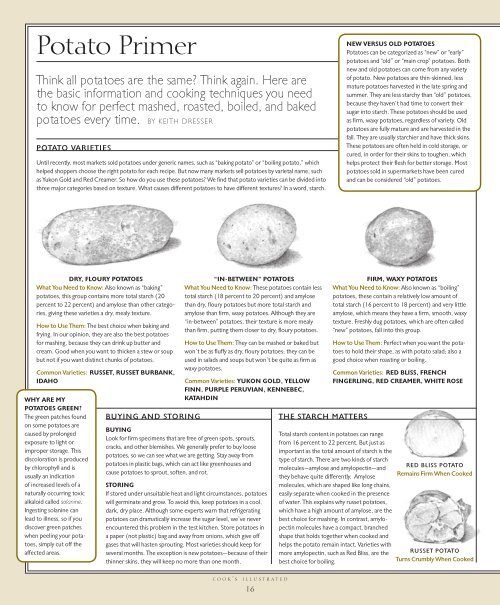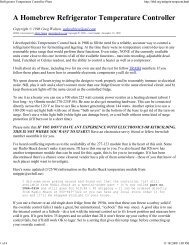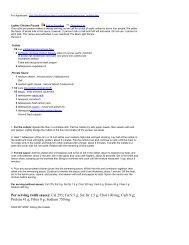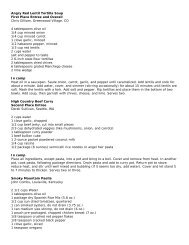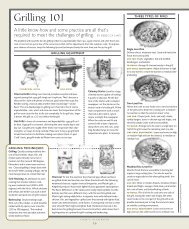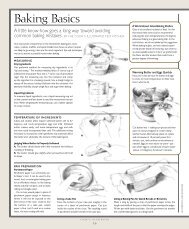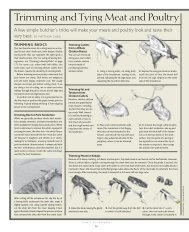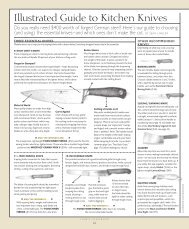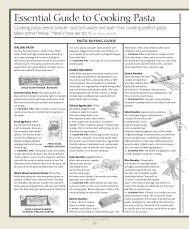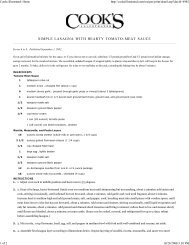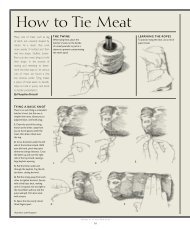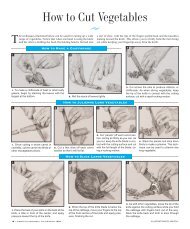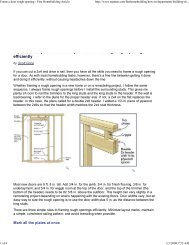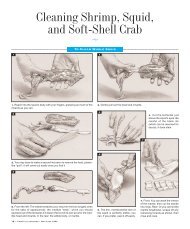You also want an ePaper? Increase the reach of your titles
YUMPU automatically turns print PDFs into web optimized ePapers that Google loves.
<strong>Potato</strong> <strong>Primer</strong><br />
Think all potatoes are the same? Think again. Here are<br />
the basic information and cooking techniques you need<br />
to know for perfect mashed, roasted, boiled, and baked<br />
potatoes every time. By Keith Dresser<br />
POTATO VA RIETIES<br />
Until recently, most markets sold potatoes under generic names, such as “baking potato” or “boiling potato,” which<br />
helped shoppers choose the right potato for each recipe. But now many markets sell potatoes by varietal name, such<br />
as Yukon Gold and Red Creamer. So how do you use these potatoes? We find that potato varieties can be divided into<br />
three major categories based on texture. What causes different potatoes to have different textures? In a word, starch.<br />
new versus old potatoes<br />
<strong>Potato</strong>es can be categorized as “new” or “early”<br />
potatoes and “old” or “main crop” potatoes. Both<br />
new and old potatoes can come from any variety<br />
of potato. New potatoes are thin-skinned, less<br />
mature potatoes harvested in the late spring and<br />
summer. They are less starchy than “old” potatoes,<br />
because they haven’t had time to convert their<br />
sugar into starch. These potatoes should be used<br />
as firm, waxy potatoes, regardless of variety. Old<br />
potatoes are fully mature and are harvested in the<br />
fall. They are usually starchier and have thick skins.<br />
These potatoes are often held in cold storage, or<br />
cured, in order for their skins to toughen, which<br />
helps protect their flesh for better storage. Most<br />
potatoes sold in supermarkets have been cured<br />
and can be considered “old” potatoes.<br />
DRY, FLOURY POTATOES<br />
What You Need to Know: Also known as “baking”<br />
potatoes, this group contains more total starch (20<br />
percent to 22 percent) and amylose than other categories,<br />
giving these varieties a dry, mealy texture.<br />
How to Use Them: The best choice when baking and<br />
frying. In our opinion, they are also the best potatoes<br />
for mashing, because they can drink up butter and<br />
cream. Good when you want to thicken a stew or soup<br />
but not if you want distinct chunks of potatoes.<br />
Common Varieties: Russet, Russet Burbank,<br />
Idaho<br />
Why Are My<br />
<strong>Potato</strong>es Green?<br />
The green patches found<br />
on some potatoes are<br />
caused by prolonged<br />
exposure to light or<br />
improper storage. This<br />
discoloration is produced<br />
by chlorophyll and is<br />
usually an indication<br />
of increased levels of a<br />
naturally occurring toxic<br />
alkaloid called solanine.<br />
Ingesting solanine can<br />
lead to illness, so if you<br />
discover green patches<br />
when peeling your potatoes,<br />
simply cut off the<br />
affected areas.<br />
B U Y I N G A N D STO R I N G<br />
“IN-BETWEEN” POTATOES<br />
What You Need to Know: These potatoes contain less<br />
total starch (18 percent to 20 percent) and amylose<br />
than dry, floury potatoes but more total starch and<br />
amylose than firm, waxy potatoes. Although they are<br />
“in-between” potatoes, their texture is more mealy<br />
than firm, putting them closer to dry, floury potatoes.<br />
How to Use Them: They can be mashed or baked but<br />
won’t be as fluffy as dry, floury potatoes; they can be<br />
used in salads and soups but won’t be quite as firm as<br />
waxy potatoes.<br />
Common Varieties: Yukon Gold, Yellow<br />
Finn, Purple Peruvian, Kennebec,<br />
Katahdin<br />
Buying<br />
Look for firm specimens that are free of green spots, sprouts,<br />
cracks, and other blemishes. We generally prefer to buy loose<br />
potatoes, so we can see what we are getting. Stay away from<br />
potatoes in plastic bags, which can act like greenhouses and<br />
cause potatoes to sprout, soften, and rot.<br />
Storing<br />
If stored under unsuitable heat and light circumstances, potatoes<br />
will germinate and grow. To avoid this, keep potatoes in a cool,<br />
dark, dry place. Although some experts warn that refrigerating<br />
potatoes can dramatically increase the sugar level, we’ve never<br />
encountered this problem in the test kitchen. Store potatoes in<br />
a paper (not plastic) bag and away from onions, which give off<br />
gases that will hasten sprouting. Most varieties should keep for<br />
several months. The exception is new potatoes—because of their<br />
thinner skins, they will keep no more than one month.<br />
c o o k ’ s i l l u s t r a t e d<br />
16<br />
T h e Sta rch M at t e r s<br />
FIRM, WAXY POTATOES<br />
What You Need to Know: Also known as “boiling”<br />
potatoes, these contain a relatively low amount of<br />
total starch (16 percent to 18 percent) and very little<br />
amylose, which means they have a firm, smooth, waxy<br />
texture. Freshly dug potatoes, which are often called<br />
“new” potatoes, fall into this group.<br />
How to Use Them: Perfect when you want the potatoes<br />
to hold their shape, as with potato salad; also a<br />
good choice when roasting or boiling.<br />
Common Varieties: Red Bliss, French<br />
Fingerling, Red Creamer, White Rose<br />
Total starch content in potatoes can range<br />
from 16 percent to 22 percent. But just as<br />
important as the total amount of starch is the<br />
type of starch. There are two kinds of starch<br />
molecules—amylose and amylopectin—and<br />
they behave quite differently. Amylose<br />
molecules, which are shaped like long chains,<br />
easily separate when cooked in the presence<br />
of water. This explains why russet potatoes,<br />
which have a high amount of amylose, are the<br />
best choice for mashing. In contrast, amylopectin<br />
molecules have a compact, branched<br />
shape that holds together when cooked and<br />
helps the potato remain intact. Varieties with<br />
more amylopectin, such as Red Bliss, are the<br />
best choice for boiling.<br />
RED BLISS POTATO<br />
Remains Firm When Cooked<br />
RUSSET POTATO<br />
Turns Crumbly When Cooked
COOKING POTATO E S<br />
Mashed<br />
Start with dry, floury potatoes and simmer<br />
them with their peels on. Yes, this is more<br />
work than the usual peel-and-dice method,<br />
but keeping water out ensures fluffy<br />
mashed potatoes with an earthy flavor. It is<br />
also important when mixing the potatoes<br />
to add the melted butter before the halfand-half.<br />
When butter is added before<br />
the half-and-half, the fat coats the starch<br />
molecules, inhibiting their interaction with<br />
the water in the half-and-half. The result is<br />
a silkier, creamier mashed potato.<br />
Baked<br />
Start with a dry, floury potato and bake<br />
it at a relatively low temperature, which<br />
allows some of the starch in the flesh<br />
just inside the skin to break down into<br />
sugar and gives the potato a rich flavor. To<br />
ensure that the flesh does not steam and<br />
become dense, open a baked potato as<br />
soon as it comes out of the oven.<br />
Roasted<br />
Start with waxy potatoes (they have more<br />
moisture than other varieties) and cover<br />
the pan with foil for the first half of the<br />
roasting time so the potatoes steam in their<br />
own moisture and become creamy. Remove<br />
the foil and continue roasting until the<br />
exteriors are crisp.<br />
Boiled<br />
Start with firm, waxy potatoes and boil<br />
them with their skin intact. Toss with<br />
butter and serve, or, for salad, cut and toss<br />
potatoes with vinegar, salt, and pepper.<br />
This technique allows the potatoes to<br />
easily absorb the vinegar, creating a fullerflavored<br />
salad.<br />
Peeling Hot <strong>Potato</strong>es<br />
The most efficient way to peel a just-boiled<br />
potato is to spear it with a fork and then<br />
use a paring knife to remove the peel.<br />
Opening a Baked <strong>Potato</strong><br />
Use the tines of a fork to make a<br />
dotted X on top of each potato.<br />
Press in at the ends of the potato to<br />
push the flesh up and out. Besides<br />
releasing the steam quickly, this<br />
method helps trap and hold on to<br />
bits of butter.<br />
Flipping Roast <strong>Potato</strong>es<br />
Press a metal spatula against the pan<br />
as you slide it under the potatoes<br />
to protect the crisp crust. Flip the<br />
potatoes so that the other cut sides<br />
come in contact with the hot pan.<br />
Is It Done Yet?<br />
Poke the potato with a sharp paring<br />
knife and then try to lift it out of the<br />
water. If the potato clings to the knife<br />
even for a second, back into the pot<br />
it goes.<br />
if you must peel<br />
Over the years, we’ve tried<br />
many different peelers, and we<br />
recommend the OXO I-Series<br />
Swivel Peeler ($10). This sturdy,<br />
maneuverable, and incredibly<br />
sharp peeler simply outdoes<br />
the competition.<br />
basic potato recipes<br />
M A S H E D P O TAT O E S S e r v e s 4<br />
Place 2 pounds scrubbed (and<br />
unpeeled) dry, floury potatoes in large<br />
saucepan with cold water to cover by<br />
about 1 inch. Bring to boil, then simmer<br />
over medium-low heat until tender and<br />
fully cooked (see illustration below),<br />
20 to 30 minutes. Drain and peel<br />
potatoes. Mill, rice, or mash potatoes<br />
(see “Three Tools for Mashing”). Stir in<br />
8 tablespoons melted unsalted butter,<br />
followed by 1 cup warm half-and-half.<br />
Season with 1 1 ⁄2 teaspoons table salt<br />
and ground black pepper to taste.<br />
B A K E D P O TAT O E S S e r v e s 4<br />
Place 4 medium dry, floury potatoes<br />
directly on middle rack in 350-degree<br />
oven. Bake potatoes until skewer glides<br />
easily through flesh, about 1 hour and<br />
15 minutes. Open immediately (see<br />
illustration at left), and serve with butter<br />
and salt.<br />
R O A S T E D P O TAT O E S S e r v e s 4<br />
Toss 2 pounds firm, waxy potatoes, cut<br />
into 3 ⁄4-inch wedges, with 3 tablespoons<br />
olive oil, salt, and pepper. Place potatoes<br />
flesh side down on rimmed baking<br />
sheet and cover tightly with foil. Cook<br />
potatoes on middle rack in 425-degree<br />
oven for 20 minutes. Remove foil and<br />
continue to roast until sides of potatoes<br />
touching pan are golden brown, about<br />
15 minutes. Carefully turn potatoes over<br />
and continue to roast until golden brown<br />
on the second side, 5 to 10 minutes.<br />
B O I L E D P O TAT O E S S e r v e s 4<br />
i l l u st r at i o n : J o h n b u rg oy n e<br />
T hree Tools for M a s h i n g<br />
Hand Masher: For chunky, home-style<br />
mashed potatoes, the tool of choice is a<br />
hand masher. These mashers come in all<br />
shapes and styles, but our choice is the Profi<br />
Plus Masher ($15.99). With its perforated<br />
disk and comfortable grip, the Profi mashes<br />
potatoes with minimum effort.<br />
Food Mill: Part food processor<br />
and part sieve, a food mill quickly<br />
produces silky mashed potatoes<br />
while separating out any stray peels.<br />
Of the food mills tested in the<br />
kitchen, our favorite is the R.S.V.P.<br />
Rotary Food Mill ($19.95).<br />
Ricer: Like a food mill, the ricer purees the<br />
potato while removing any unwanted skins.<br />
The drawback to a ricer is that its hopper is<br />
quite small and it requires a fair amount of<br />
elbow grease, which makes processing a large<br />
batch of potatoes laborious. Our favorite is<br />
the Cuisipro <strong>Potato</strong> Ricer ($29.95).<br />
Place 2 pounds scrubbed firm, waxy<br />
potatoes in large saucepan with cold<br />
water to cover by about 1 inch. Bring<br />
to boil, then simmer over medium-low<br />
heat until tender, at least 10 minutes for<br />
1-inch potatoes and up to 18 minutes<br />
for 2 1 ⁄2-inch potatoes. Drain and toss<br />
with butter.<br />
FOR SALAD: Cool potatoes slightly, cut<br />
with serrated knife into 3 ⁄4-inch chunks,<br />
and place on rimmed baking sheet.<br />
Drizzle with 1 ⁄4 cup red wine vinegar,<br />
1<br />
⁄2 teaspoon salt, and 1 ⁄4 teaspoon pepper.<br />
Let stand for 20 minutes, then<br />
transfer to bowl and dress as desired.<br />
j a n u a r y & f e b r u a r y 2 0 0 7<br />
17


